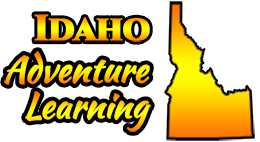Boise WaterShed
Submitted by Amber Powers on Mon, 2016-07-11 00:00
The first day of MILES Adventure Learning is underway. We are here in the classroom center at the Boise WaterShed learning the frameworks or "big idea" to help new facts and information stick to our brains. Big IDEA: We live within a watershed which is structure that funnels water to a specific geographic location. It is a natural system starting from the tops of a ridgeline where water flows to vallleys by way of riviers, tributaries, and manmade structures such as canals. The Boise watershed feeds the Treasure Valley.
I am connected to the Boise River watershed because I have lived in the Treasure Valley all my life. Without the watershed I would not have the ability to live here just as anyone else. We need to watershed to for drinking water, for recreation, such as swimming, and camping in our beautiful landscapes. The watershed provides plants and animals with healthy water, plants and animals that I can recognize and photograph. The watershed allows me to have a nice lawn with landscaping. Without the watershed, I would not be able to shower! (And that is a scary thought).
Question for Digi-Learner: What are some ways we can help our students become more aware of how a watershed works and how they are personally connected to our Boise watershed?

Comments
Personally Connected to our Boise Watershed
It's nice that we live in such a rual state that relies so heavily on Agriculture. I feel this helps to make a solid connection to most of the students where I taught, in Caldwell, because their families rely so heavily on the fields for a job. There are also many of the students who camp, hunt, and fish, so doing the classroom activity with the crumpled paper really helped connect for them where good locations to have recreational activities were. From there, I also had them look at a topigraphical map and locate a place somewhere simliar to their paper map they created. They had to then find recreational locations, cities, and other sites and explain why those sites were created in those locations. We discussed how things like mudslides, pestesides, trash dumps, and other things that could affect the watershed could then affect all of those sites around there. I think it became meaningful to most of them because it scaled it down for them to see how large a watershed can be and all of the people and places that can be affected by a small disaster.
Personally connected to the Boise Watershed
I do not live in the Treasure Valley area, but I am personally connected to the Boise Watershed by recreational use. I have floated down the Boise river and I have enjoyed bike rides on the green belt by the river. I have gone camping and fishing in areas connected to the Boise watershed. When we discuss the water cycle in my classroom, we have not discussed the Idaho watersheds and the relationship the kids have with it. I plan to change that and I plan to use the crumpled topography activity described to show students a visual example of a watershed. Living in a rural community students understand farming and local water issues, but I am guessing that they are not well informed about where that water comes from exactly. I am also guessing that they do not consider the pesticides and herbicides used by farmers that could end up in their own watershed.
Connected to Watershed
I remember teaching one time and we were discussing how the Treasure Valley is a desert and some of my students did not realize that. I think it is imperative to our future that our students understand how precious water here is. Now many of them do know it because they are more linked into the system by farming or recreating. As the Treasure Valley continues to grow we need to make sure that people coming in realize the value of water. I also have used the crumple actvity with students to get them to understand the concept of a watershed. I also make them do mapping activities where they have to think about how all the water in our country is tied together. How many watershed are there to serve how many people? I also ask students to think about what we use water for and how much they use that is just wasted and where does that water go? The biggest use of water is for grass, is that really a good use of a limited resource? We all depend on the river for so many things one that I often forget about is just the scenic value and how water offers us a kind of peace. I would like to focus more with my students how complicated water use can get and help them to better understand the complex water rights in our state.